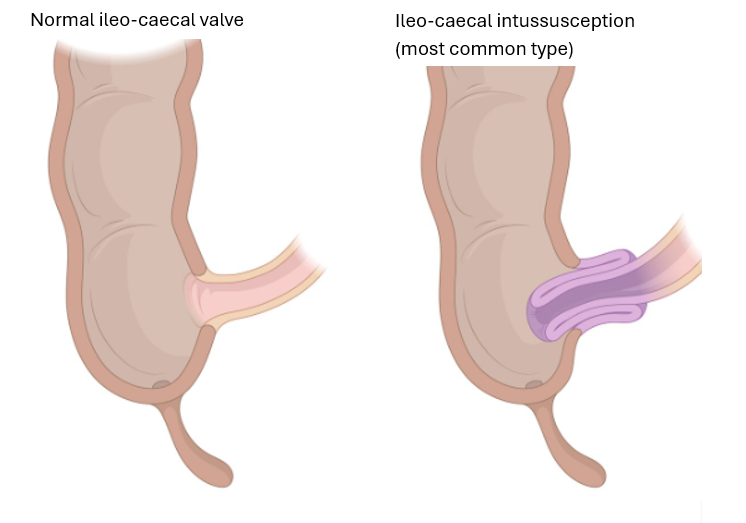Intussusception is a serious medical condition that happens when a part of the intestine folds into itself, leading to a blockage. This condition happens most commonly in children but can also affect adults. Understanding the symptoms, causes, and treatment options for intussusception is important for timely diagnosis and treatment.
What is Intussusception?
Imagine a worm moving along the ground. The back part of the body of the worm moves forward and scrunches into itself, and then the front of the worm moves forward. In this manner the worm moves from one point to another.
The human intestine does something similar when moving food along, the top part (proximal bowel) of bowel i.e. the piece that is closer to the mouth, pushes food forward and to the next part of the bowel (the distal bowel). Sometimes the proximal bowel gets stuck in the distal bowel and an intussusception occurs.
Intussusception is therefore a type of intestinal blockage that occurs when one piece of the intestine telescopes or worms into the piece of intestine next to it. This folding can cause swelling which then decreases the blood flow to the affected intestines, and can lead to serious complications. Once the affected section of the intestine is swollen, the food cannot pass through which then leads to symptoms like abdominal pain and vomiting.

Types of Intussusception
Ileo-caecal Intussusception: The most common form, where the ileum (the last part of the small intestine) telescopes into the caecum.

Ileal Intussusception: Involves the ileum folding into itself.
Colonic Intussusception: The colon folds into itself, which is more common in adults.
Who gets Intussuscception?
Intussusception can happen to anyone, but it is far more common in children aged 6 months to 3 years. This happens because children have special lymph glands in their bowels that are very active in the protection from infection. These special lymph glands act as a lead point.
In adults, it can occur due to underlying conditions such as tumors or inflammatory bowel disease.
Symptoms of Intussusception
Identifying the symptoms of intussusception is important for quick diagnosis and treatment. Common symptoms include:
- Severe Tummy Pain: This pain may come and go in waves and can be localised to one area in the tummy or felt all over the tummy (generalised).
- Vomiting: This may start off mild but then becoming more severe as the blockage worsens.
- Tummy (abdominal) Swelling: A noticeable bulge may be felt or seen on the tummy due to the stretching of the intestine.
- Changes in poop habits (bowel movements): Children may pass blood or mucus (mucus looks like slimy snot) from the bum or experience changes in poop (stool) consistency. Children with intussusception often pass poop that looks like red jam or jelly. The poop has this appearance and consistency because of blood mixed with mucus.
- Lethargy or Irritability: Children may appear unusually tired or fussy.
In adults, symptoms may include chronic abdominal pain, bloating, and changes in pooping habits.
Causes of Intussusception
The exact cause of intussusception can vary, and in many cases, it is unknown. However, several factors can contribute to the condition:
Infections: Viral infections, such as rotavirus, can lead to swelling of the lymphatic tissue (special lymph glands) in the intestines, triggering intussusception in children.
Lead Points: In adults, tumors or other abnormalities in the intestine can act as lead points that initiate the telescoping/ worming process.
Previous Abdominal Surgery: Scar tissue from previous surgeries can increase the risk of intussusception.
Diagnosis of Intussusception
If intussusception is suspected, quick medical evaluation is essential. Healthcare providers may use various diagnostic tools, including:
- Physical Examination: Doctors will assess symptoms and check the tummy for pain and swelling, and feel for lumps in the tummy.
- Imaging Studies: An abdominal ultrasound is commonly used in children to see the intussusception. CT scans may be ordered in adults for a more detailed view.
- X-rays: These may be used to check for signs of obstruction (blockage) or abnormal gas patterns in the intestines.
Treatment Options
Timely treatment of intussusception is important to prevent complications such as tissue damage or perforation (hole).
Treatment options may include:
Non-Surgical Reduction: In many cases, especially in children, intussusception can be treated with a water enema. The bowel is filled with water, and under ultrasound guidance the surgeon and radiologist watch the intussusception being moved and opened up. This is the treatment of choice in children.

Surgery: If non-surgical methods are unsuccessful or if the intussusception is complicated (such as in cases of bowel hole or severe damage (necrosis)), surgery may be necessary. The surgeon will reduce the intussusception and may need to remove any damaged sections of the intestine.
Supportive Care: Patients may require hospitalization for observation and supportive care, including IV fluids and pain management.
Prognosis and Complications
With prompt treatment, the outcome for intussusception is generally good. Most children recover fully without long-term complications. However, if not treated, intussusception can lead to serious complications:
- Bowel Necrosis (death of the tissue): Prolonged blockage can lead to the death of intestinal tissue, needing more extensive surgery.
- Perforation: A tear/hole in the intestinal wall can lead to infection in the abdomen (peritonitis), which can be life-threatening as the poop and all the bacteria in the poop are released into the belly.
- Recurrent Intussusception: Some children may experience repeated episodes, requiring further medical intervention.
Conclusion
Intussusception is a potentially serious condition that needs immediate medical attention. Understanding the symptoms and causes can help parents and healthcare providers act quickly to ensure the best possible outcomes. If you suspect that someone may be experiencing intussusception, seek medical help quickly to prevent complications and ensure timely treatment. With awareness and prompt action, intussusception can be effectively managed, allowing for a swift return to health.
Written by Dr Caroline Zabiegaj-Zwick, Paediatric Surgeon
